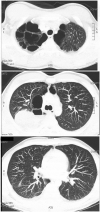Sudden onset polyarthritis as a paraneoplastic syndrome from non-small cell lung cancer
- PMID: 32850061
- PMCID: PMC7425616
- DOI: 10.1080/20009666.2020.1749503
Sudden onset polyarthritis as a paraneoplastic syndrome from non-small cell lung cancer
Abstract
A 48-year-old male presented to the emergency room for 2 weeks of joint pain and swelling of his four extremities. His symptoms started suddenly and were quite debilitating. His hands, fingers, knees, and ankles were so swollen and painful that he was unable to get out of bed and had to use crutches to ambulate. He also complained of anorexia, nausea, and lack of energy over the past few months, but denied any other complaints. His only medical history was a traumatic left tibia fracture 1 year ago. The patient had a 30-pack year history of smoking tobacco and used marijuana daily. The patient recently had an arthrocentesis at an outside hospital which was non-diagnostic and showed no infection. Given his symptoms, a thorough rheumatic workup was ordered. The ESR and CRP were elevated. ANA, rheumatoid factor, HLA B27, HIV, hepatitis panel, TSH, T4, Coombs antibodies, gonorrhea, chlamydia, CCP, alpha 1 antitrypsin, parvovirus, fungal antibodies, and myeloperoxidase antibodies were all within the normal range. X-rays of the hands, knees, and ankles were ordered. The images showed diffuse joint swelling with no fractures, dislocations, or hardware mispositioning. It also showed tissue swelling in the fingers that could not exclude hypertrophic pulmonary osteoarthropathy. A chest x-ray revealed a large 8.5 cm oval mass in the right upper lobe. A follow-up CT revealed a massive right upper lobe lung mass concerning for malignancy versus fungal etiology. A CT guided biopsy of the mass was performed and revealed a poorly differentiated non-small-cell lung cancer, favoring adenocarcinoma. Further CT imaging revealed limited stage disease. During the hospitalization, the patient was provided with NSAIDs for his joint pain, which provided minimal benefit. There was little to no improvement in his joint swelling. Oncology was consulted and further evaluation in the outpatient setting was recommended to determine if he would be a surgical candidate and/or to decide the best chemotherapeutic regimen. This case demonstrates an unusual presentation of non-small-cell lung cancer and highlights the importance of maintaining malignancy on the differential diagnosis for sudden arthritis.
Keywords: Clubbing; bronchogenic carcinoma; hypertrophic osteoarthropathy; lung cancer; paraneoplastic.
© 2020 The Author(s). Published by Informa UK Limited, trading as Taylor & Francis Group on behalf of Greater Baltimore Medical Center.
Conflict of interest statement
No potential conflict of interest was reported by the authors.
Figures
References
-
- Yao Q, Altman RD, Brahn E.. Periostitis and hypertrophic pulmonary osteoarthropathy: report of 2 cases and review of the literature. Semin Arthritis Rheum. 2009;38(6):458–466. - PubMed
-
- Ito T, Goto K, Yoh K, et al. Hypertrophic pulmonary osteoarthropathy as a paraneoplastic manifestation of lung cancer. J Thorac Oncol. 2010;5(7):976–980. - PubMed
-
- Castori M, Sinibaldi L, Mingarelli R, et al. Pachydermoperiostosis: an update. Clin Genet. 2005;68(6):477–486. - PubMed
-
- Jajic Z, Jajic I, Nemcic T. Primary hypertrophic osteoarthropathy: clinical, radiologic, and scintigraphic characteristics. Arch Med Res. 2001;32(2):136–142. - PubMed
Publication types
LinkOut - more resources
Full Text Sources
Research Materials
Miscellaneous





